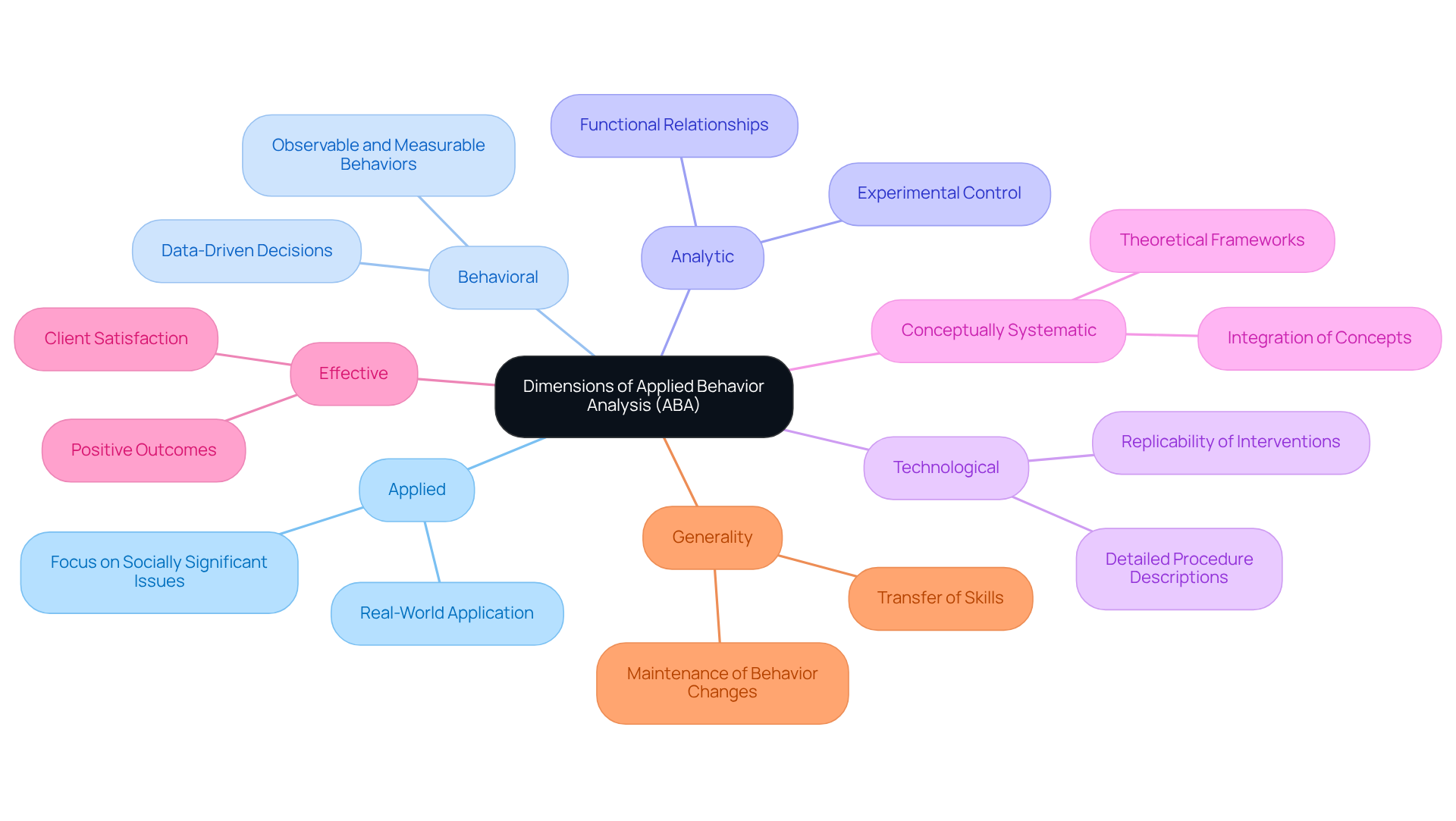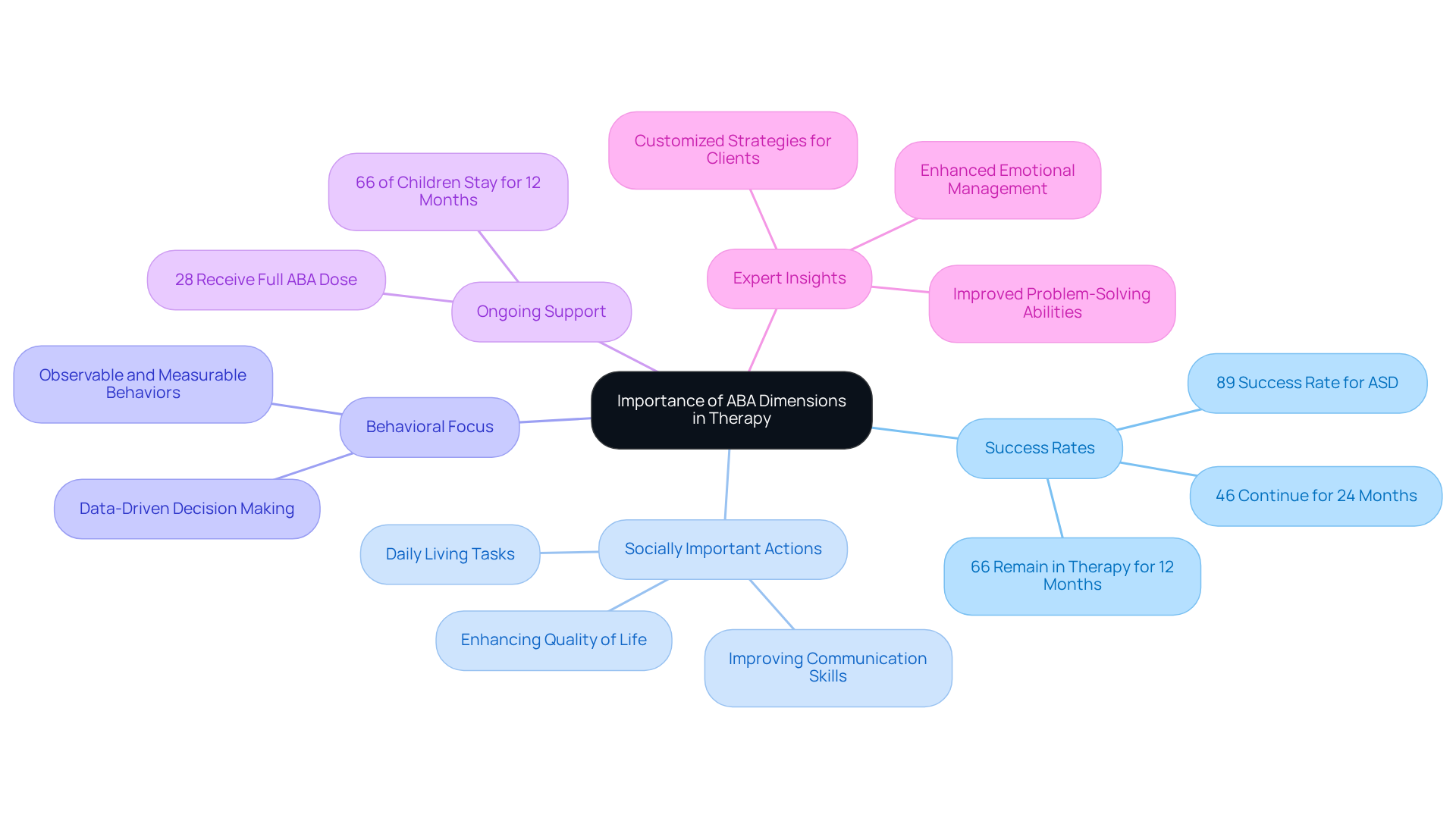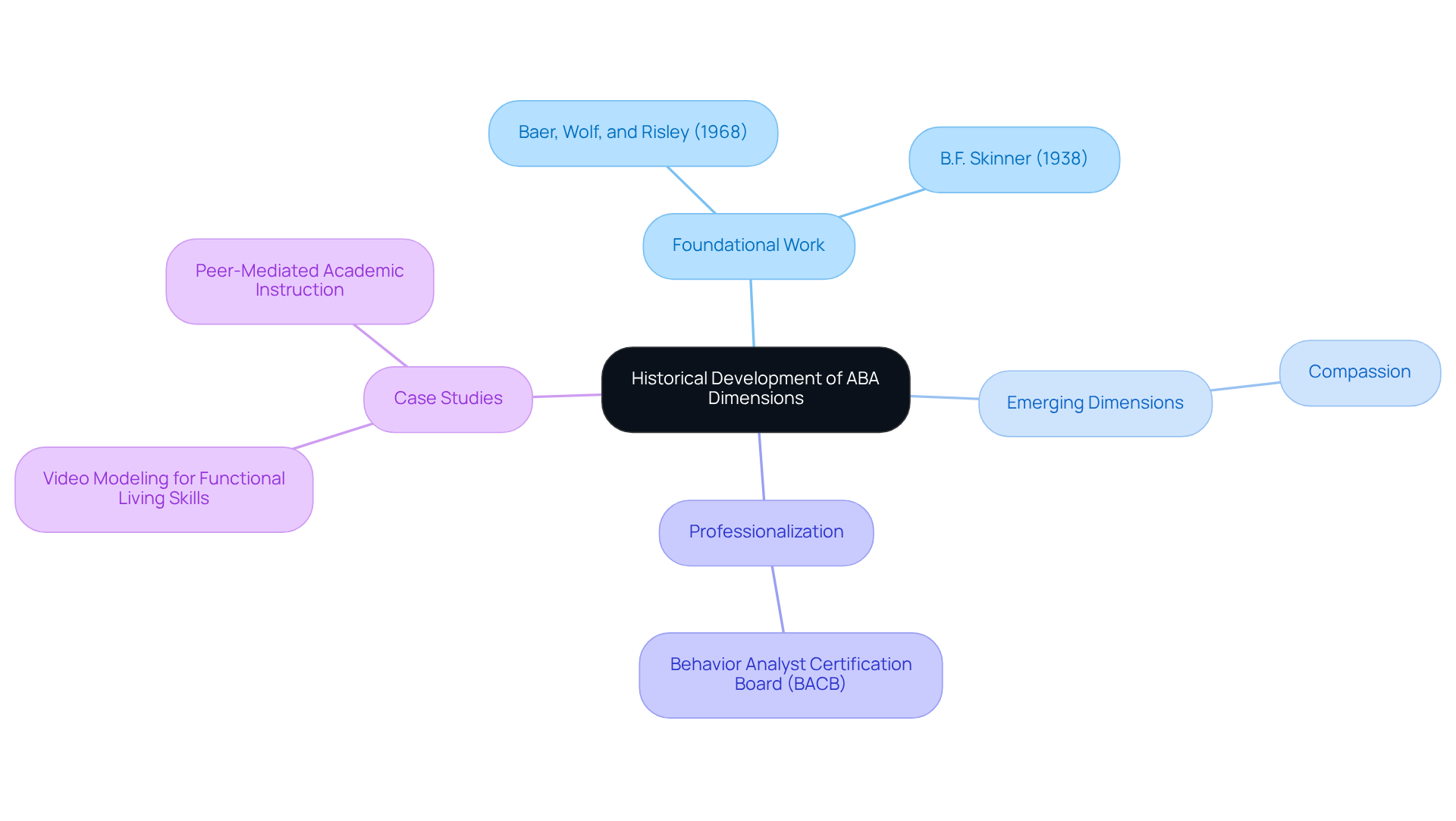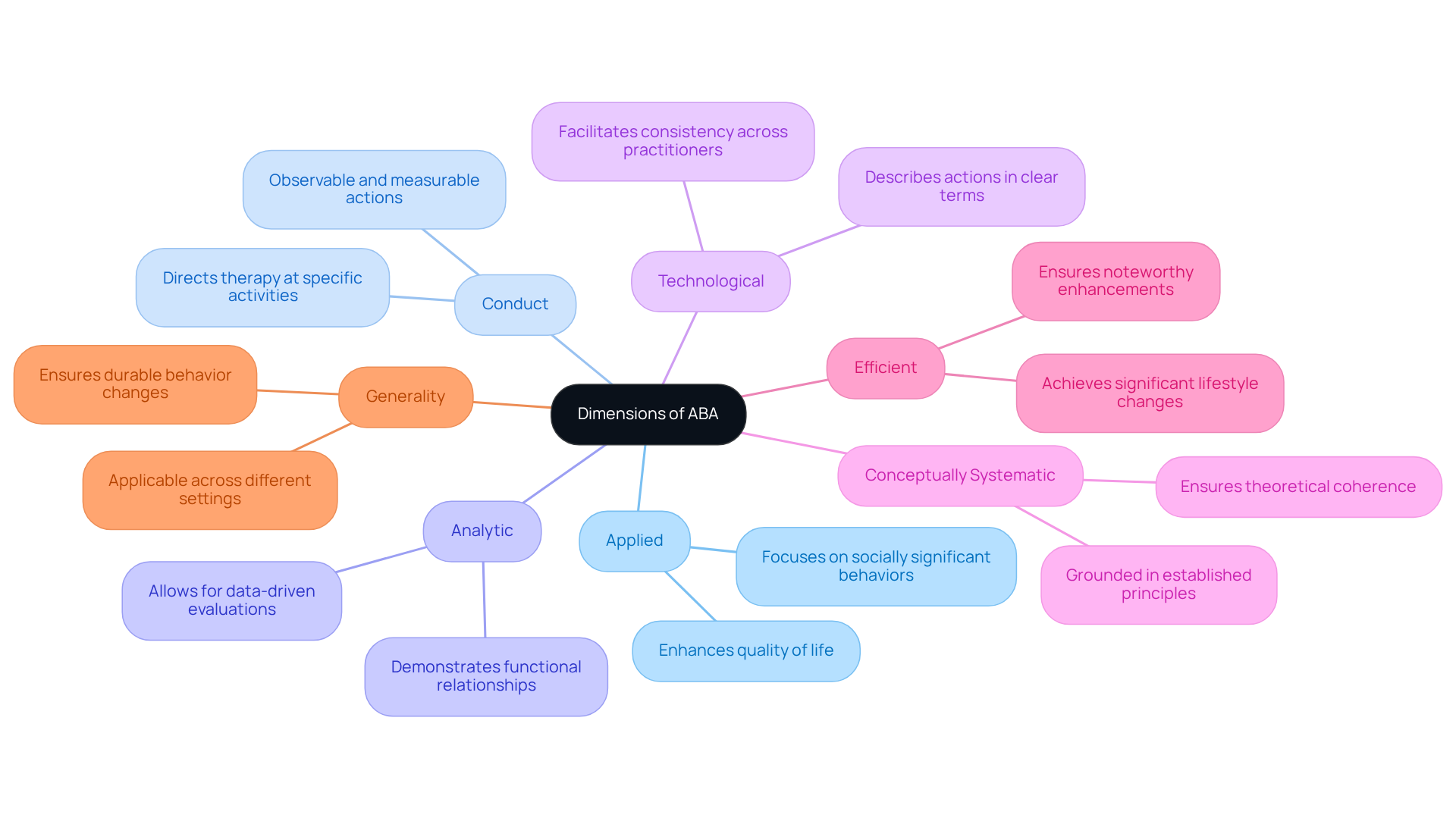July 1, 2025

The article delves into the dimensions of Applied Behavior Analysis (ABA), shedding light on their significance and characteristics in delivering effective therapy. It articulates seven essential dimensions:
Each dimension serves as a guiding principle, ensuring that interventions are ethical, evidence-based, and specifically designed to enhance the quality of life for individuals receiving ABA services. This structured approach not only underscores the importance of these dimensions but also establishes a framework for effective therapeutic practices.
Understanding the dimensions of Applied Behavior Analysis (ABA) is essential for professionals committed to improving therapeutic outcomes. These dimensions—Applied, Behavioral, Analytic, Technological, Conceptually Systematic, Effective, and Generality—create a framework that guarantees interventions are both ethical and impactful.
With the growing demand for effective ABA practices, practitioners must consider:
This inquiry not only highlights the importance of these foundational elements but also reveals the transformative potential they possess in shaping successful therapeutic strategies.
The dimensions of ABA represent a critical framework that delineates the essential qualities of effective ABA practice. Initially articulated by Baer, Wolf, and Risley in 1968, these aspects—Applied, Behavioral, Analytic, Technological, Conceptually Systematic, Effective, and Generality—serve as guiding principles. Each aspect is designed to ensure that interventions are ethical, evidence-based, and focused on enhancing socially significant behaviors.
Understanding the dimensions of ABA is not merely beneficial; it is vital for professionals aiming to deliver tailored to the needs of individuals receiving ABA services. Are you equipped with the knowledge to implement these principles in your practice? Grasping these foundational elements will empower you to elevate your therapeutic interventions and positively impact the lives of those you serve.

The dimensions of ABA are pivotal in ensuring that therapy is both effective and meaningful for clients. Did you know that ABA therapy boasts an impressive success rate of over 89% in treating autism spectrum disorder (ASD) in children? By focusing on socially important actions, practitioners can devise strategies that resonate with the individual's life context. For instance, the utilized aspect underscores the necessity for actions aimed at enhancing factors that elevate quality of life, such as improving communication abilities and daily living tasks. This focus is further validated by evidence demonstrating significant advancements across various developmental areas.
Moreover, statistics reveal that approximately 1 in 35 children aged 3-17 are diagnosed with ASD, underscoring the relevance of ABA therapy in addressing the needs of this substantial population. The behavioral dimension emphasizes the critical importance of concentrating on observable and measurable behaviors, facilitating data-driven decision-making. This structured approach not only fosters accountability but also between practitioners and clients. Notably, 66% of children referred for ABA therapy remain in services for 12 months, while 46% continue for 24 months, highlighting the effectiveness of ongoing support. Furthermore, the average adjusted ABC rise over 24 months was 2.49 points, providing a clearer view of the measurable results linked to ABA strategies.
Incorporating expert insights, it is clear that the dimensions of ABA play a significant role in enhancing client outcomes. Ralph Moller observed that children engaged in ABA practices frequently demonstrate improved problem-solving abilities and emotional management, leading to better social interactions and overall growth. By customizing strategies to meet the distinct requirements of each client, ABA practitioners can effectively assist individuals in achieving substantial progress and enhancing their quality of life. Are you ready to explore how these insights can inform your approach to ABA therapy?

The dimensions of ABA are increasingly relevant, particularly as the demand for Board Certified Behavior Analysts (BCBAs) is expected to increase by 25% by 2026. This growing need underscores the importance of .
The foundational work of Donald M. Baer, Montrose M. Wolf, and Todd R. Risley in 1968 articulated the dimensions of ABA, creating a framework for assessing intervention effectiveness that has significantly evolved over the years. The analysis of actions finds its roots in B.F. Skinner's 1938 publication, which laid the groundwork for understanding responses through empirical research.
As our understanding of human actions evolves, new dimensions of ABA that reflect advancements in behavioral science have emerged. Notably, the introduction of compassion as an eighth aspect emphasizes the essential role of empathy and responsiveness within the dimensions of ABA in therapeutic practices. This evolution necessitates that ABA practitioners adapt their methods to meet the diverse needs of clients, ensuring that strategies are both effective and ethically grounded.
The establishment of the Behavior Analyst Certification Board (BACB) in 1978 marked a pivotal moment in the professionalization of the field, further emphasizing the importance of ethical standards in practice.
Consider the implications of case studies, such as those examining the impact of video modeling on practical living skills for individuals with (ASD). These examples illustrate the real-world application of ABA principles, showcasing their significance in fostering positive change.
As the landscape of ABA continues to evolve, it is vital for practitioners to embrace ethical and effective approaches that prioritize the well-being of those they serve.
Are you facing challenges in hiring qualified BCBAs? Explore how Hire ABA can streamline your recruitment process and connect you with the right professionals to meet your needs.

Each dimension of ABA possesses unique characteristics that significantly contribute to the overall effectiveness of interventions.
Understanding the dimensions of ABA is vital for practitioners aiming to design and implement that adhere to best practices.

Understanding the dimensions of Applied Behavior Analysis (ABA) is essential for practitioners dedicated to delivering effective and ethical therapy. The dimensions—Applied, Behavioral, Analytic, Technological, Conceptually Systematic, Effective, and Generality—serve as a framework that guarantees interventions are evidence-based and focused on enhancing clients' quality of life. Mastering these principles empowers practitioners to make a significant impact on therapeutic outcomes.
Each dimension is pivotal in therapy, leading to measurable results. The Applied dimension underscores the importance of socially significant behaviors, while the Behavioral dimension prioritizes observable actions, fostering accountability and data-driven strategies. The historical evolution of these dimensions underscores the increasing significance of compassion in therapy, reinforcing the necessity for empathy in practice. With ABA therapy showcasing high success rates, particularly for individuals with autism spectrum disorder, the relevance of these dimensions is magnified by the surging demand for Board Certified Behavior Analysts (BCBAs).
In summary, the dimensions of ABA are indispensable for effective therapeutic practices. By embracing these principles, practitioners can devise impactful interventions that prioritize client well-being. The call to action is unmistakable: deepen your understanding of ABA dimensions to transform your approach and make a positive difference in the lives of those you serve.
What are the dimensions of Applied Behavior Analysis (ABA)?
The dimensions of ABA are Applied, Behavioral, Analytic, Technological, Conceptually Systematic, Effective, and Generality. These dimensions represent essential qualities of effective ABA practice.
Who initially articulated the dimensions of ABA?
The dimensions of ABA were initially articulated by Baer, Wolf, and Risley in 1968.
Why are the dimensions of ABA important?
The dimensions of ABA are important because they serve as guiding principles to ensure that interventions are ethical, evidence-based, and focused on enhancing socially significant behaviors.
How can understanding the dimensions of ABA benefit professionals?
Understanding the dimensions of ABA is vital for professionals as it enables them to deliver effective therapy tailored to the needs of individuals receiving ABA services, thereby positively impacting their lives.
What is the ultimate goal of applying the dimensions of ABA in practice?
The ultimate goal of applying the dimensions of ABA in practice is to elevate therapeutic interventions and enhance the quality of life for those receiving ABA services.
Our expert recruitment strategies and AI-driven sourcing ensure that you receive top-notch candidates quickly, without compromising on quality. Whether you’re looking for BCBAs, Clinical Directors, or RBTs, we’ve got you covered.